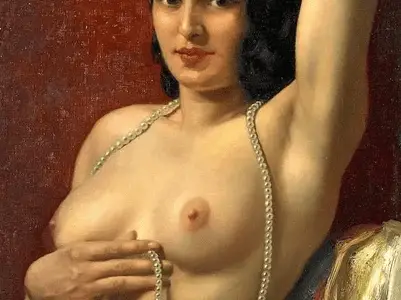
“Female Half-Nude with Pearl Necklace” (1934) by Hans Hassenteufel (German, 1887-1943)
Hans Hassenteufel was a German painter creating many portraits and female nudes, often using the Orientalist style. He occasionally painted landscape and still-life.
A portrait format image of a semi-nude female, topless with a pearl necklace. It has a deep red plane indistinct backdrop with no defining features to suggest the space. One hand holds the necklace between the fingers at the centre of the chest just below the breasts.
Her other arm is held up with the lower arm cradling the head at the back. She rests against some exotic shiny material and on her head is set an oriental-looking headpiece covering the head with exposed long flowing black hair. Her breasts are exposed. She has a plain face with red lips and she looks directly out toward the viewer. The pose has an eroticised ‘come-hither’ look as she openly displays her pert full breasts. Her uplifted arm emphasises the eroticism and sense of bodily display. She teasingly holds the snaking long pearl necklace between the breasts and the length of the necklace loops down around the body and neck encircling and emphasising the displayed breasts.
Is she a courtesan or a slave girl, enticing a potential buyer?
Orientalism was a very popular theme in painting usually with an emphasis on the luxurious life and fixation on the rather fanciful notions of the customs and exotic life in the palaces and harems from the Middle East which were usually closed off and forbidden to Western eyes. This fuelled an exotic and erotic fascination, particularly with a dualism of sexual fantasy and titillation and the moral horrors of the slave trade. There was a recurring theme of women in the harem squarely focused on the uncompromised Male Gaze demeaning women.
Although this was a specialism art genre from 19th-century academic art it was very popular in its period and remains so still as a curiosity for the breath-taking detail, realism and technical virtuosity of the paintwork.
This painting falls a little short of such deft paintwork and if I dare to say, it has some appeal with its paint handling and composition although I do find the darker tones of the visible hand a little jarring with the more natural paler skin.
Of course, with today’s rightful sensitivities to moral issues, feminism and developing female equality I find the subject matter somewhat distasteful and demeaning towards women and men.
However, it is a genre of art history and as such should not be censored from view, hidden away and condemned. History is a fact and we should learn from it and develop our thinking for the present and future. Human engagement and sexuality are confusing and certainly complex but it is a reality and as such, no subject however complex or difficult should be banned or forbidden. Artists often have unique, inciteful views and understanding of the morals and complexities of life.
























